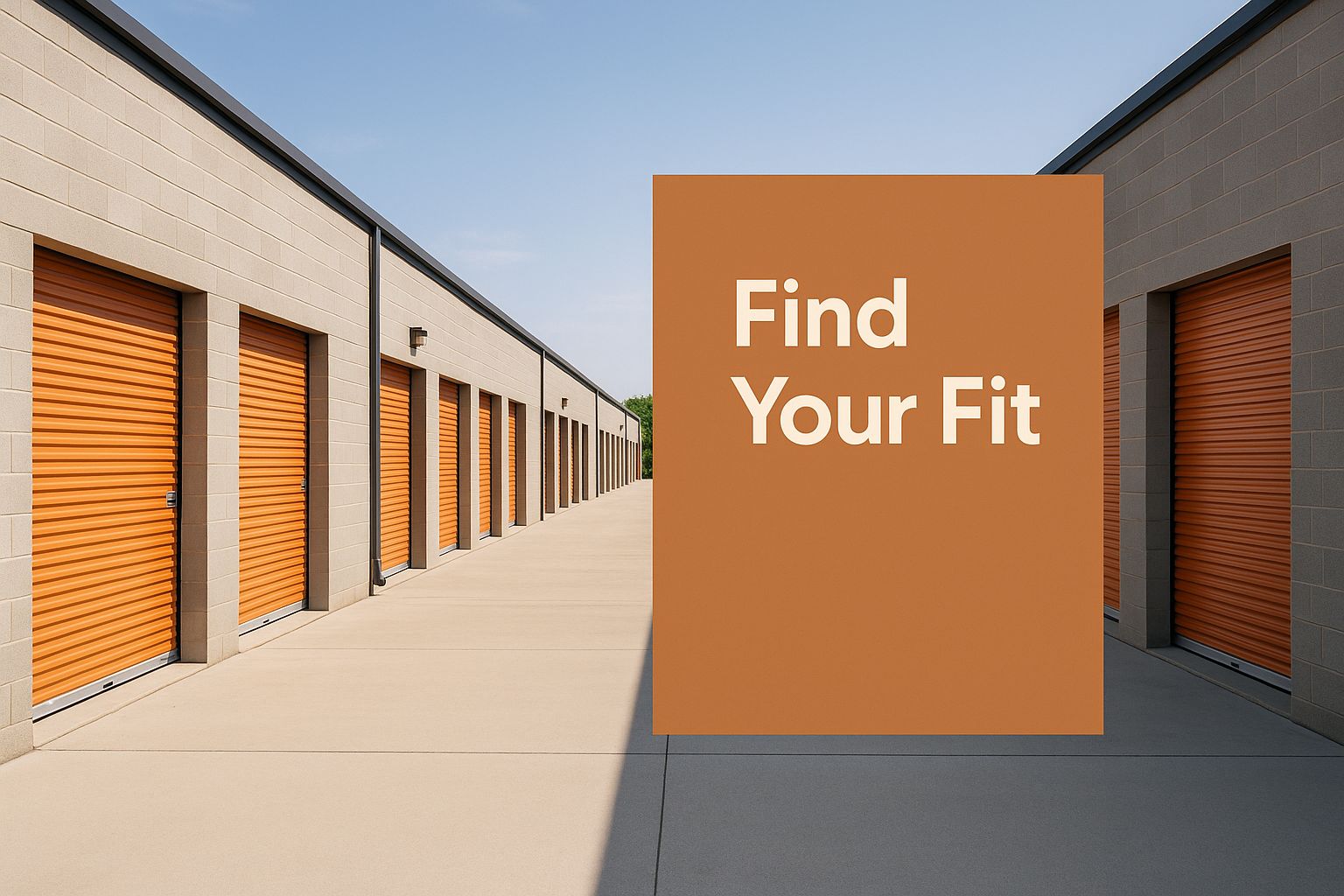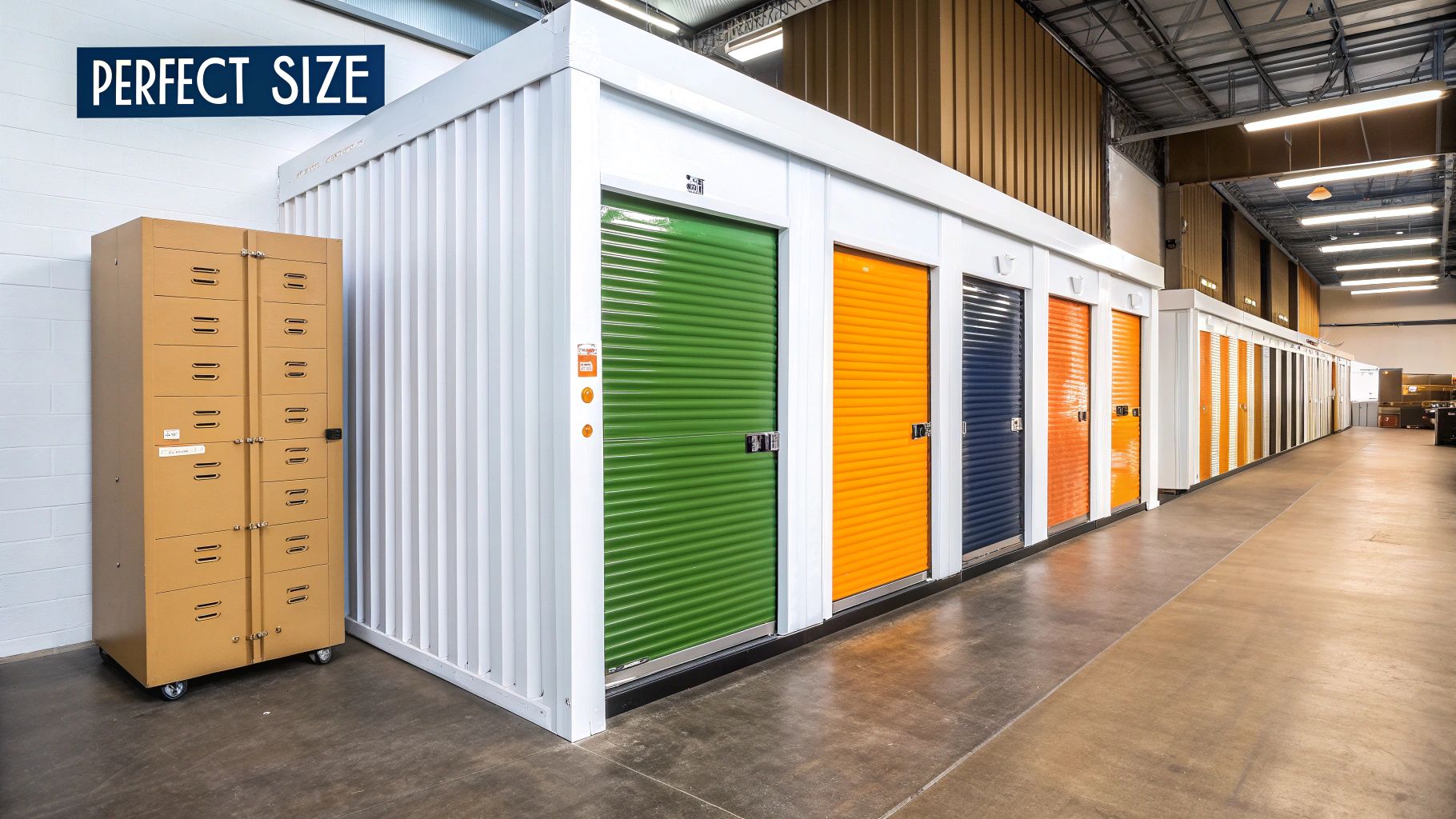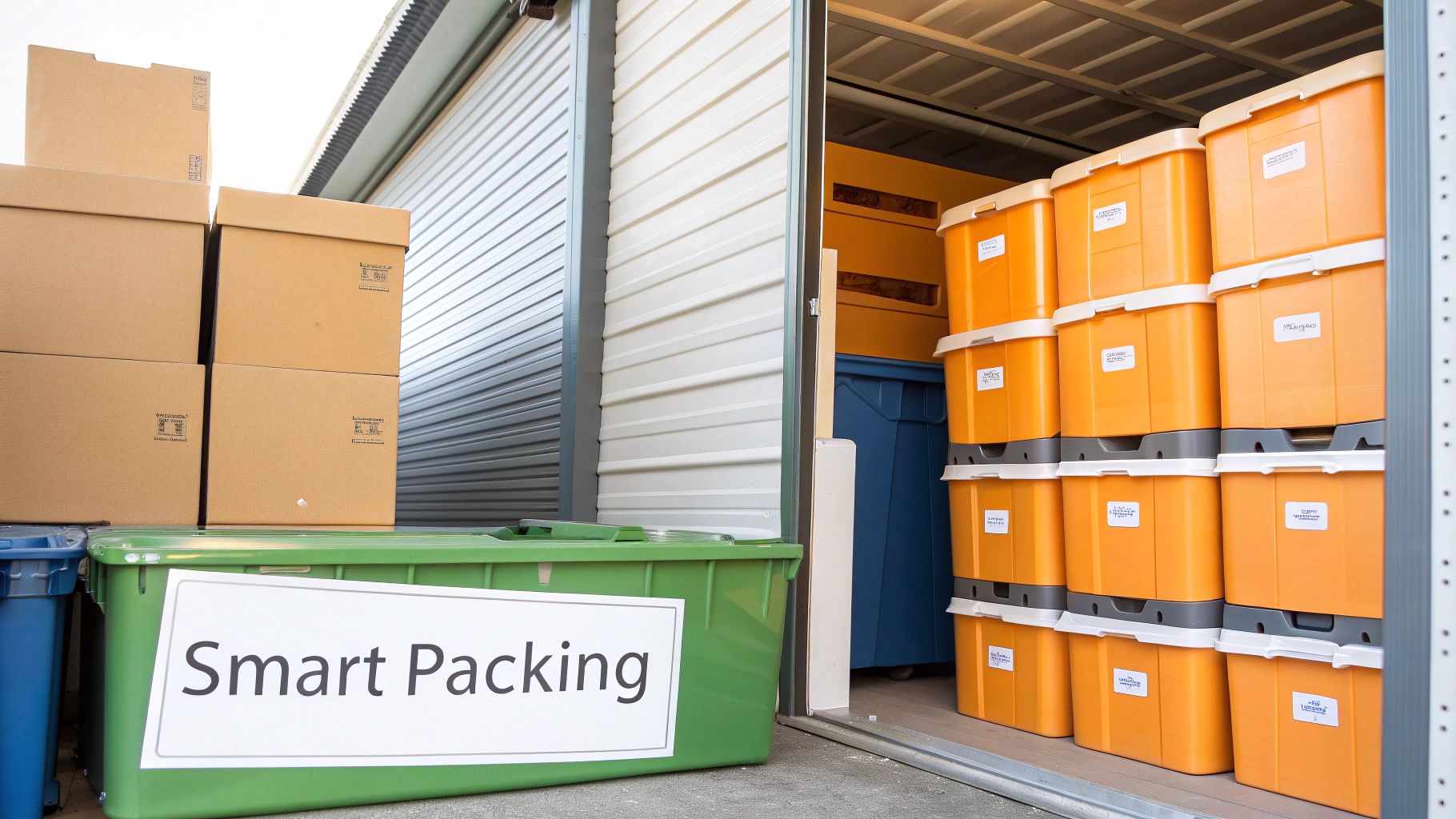Looking for a storage unit in Reading can feel like a mammoth task. Whether you’re decluttering, in the middle of a house move, or need somewhere to stash business stock, it’s easy to get overwhelmed. I'm here to cut through the noise and focus on what really matters—size, security, and access—so you can find a solution that gives you genuine value and peace of mind from day one.
Your Guide to Finding the Right Self Storage in Reading
Finding the perfect storage unit doesn’t need to be a headache. You might be a student needing a temporary home for your things over the summer, a homeowner knee-deep in renovations, or a business owner trying to manage inventory. Whatever your story, the core needs are always the same: security you can trust, convenience, and just the right amount of space. With demand for storage in Reading on the rise, making a smart choice is more important than ever.
This guide will walk you through the essential things to consider, helping you pick a facility that actually fits your life. We'll look at how to:
- Figure out what you actually need: There's no point paying for space you're not going to use.
- Know your options: Understand the difference between a simple lock-up and a fully secured, modern unit.
- Focus on the features that count: Prioritise what's most important for your specific situation.
One of the biggest tripwires I see is people not knowing where to start. They either overestimate how much room they need (and end up paying for it) or underestimate just how crucial features like 24/7 access can be. The aim is to find more than just a box to put things in; it’s about finding a functional solution that works for you.
This infographic is a great visual starting point to help you find your fit.
As you can see, a modern facility should be clean, secure, and easily accessible—these are the foundations of a good storage experience. If your needs are more short-term, like during a house move or a big decluttering project, you can explore more options for temporary storage solutions in our detailed article. Making the right decision starts with knowing what choices you have.
Choosing the Perfect Unit Size for Your Needs
Getting the right size for your storage unit in Reading is probably the most important decision you'll make. It’s the difference between a smooth, stress-free experience and the headache of paying for space you don’t need. Worse still is running out of room halfway through loading everything up.
It’s a really common mistake, but thankfully, it’s also easy to avoid. The trick is to stop thinking about abstract square footage and start picturing your actual belongings fitting neatly inside the space. The UK self storage market has grown massively, with total floorspace increasing by 7.2%, which means there's a huge variety of options out there for you. While choice is great, it also makes it even more crucial to pick the right one from the start.
Visualising Common Storage Unit Sizes
Let’s get practical and break down what these different sizes actually look like in the real world. Forget the numbers for a second and think about what you can genuinely fit inside.
-
25 sq ft Unit (Like a large walk-in wardrobe): This is your go-to for smaller jobs. It’s perfect for a student storing their uni room over the summer, holding about 30-40 medium boxes, a desk chair, and other bits and bobs. It’s also brilliant for stashing seasonal gear like skis or the lawnmower.
-
50 sq ft Unit (Think garden shed): This is one of our most popular sizes, and for good reason. It’s big enough to hold the entire contents of a studio or a roomy one-bedroom flat. You can comfortably fit a double bed, a small sofa, a chest of drawers, and plenty of boxes.
-
100 sq ft Unit (About the size of a single garage): If you’re moving out of a two-bedroom house or flat, this is usually the sweet spot. It has ample room for bigger furniture like sofas, dining tables, washing machines, and everything from two full bedrooms.
My Personal Tip: Before you do anything else, measure your biggest, most awkward items—the sofa, the mattress, the wardrobe. Those measurements will instantly tell you which smaller units are a non-starter and give you a solid baseline for the minimum size you need.
How to Tally Up Your Belongings
Before you book anything, grab your phone and make a quick inventory. No need for a complicated spreadsheet; just a simple list will do. Grouping items by room makes it much easier to visualise how much space they'll take up.
For a more in-depth look with visual examples, our complete self storage unit size guide is a great resource.
Once your list is ready, remember the golden rule of storage: think vertically. Most units have high ceilings, and using that height is how you get the best value. Get your hands on sturdy, uniform boxes that can be stacked high without collapsing. A little planning here might mean you can squeeze everything into a 75 sq ft unit instead of paying for a 100 sq ft one. It’s a simple trick that saves money and makes finding your things a lot easier down the line.
What to Look for in Security and Accessibility
When you're looking at different storage units in Reading, you're paying for more than just a box to put things in—you're buying peace of mind. Knowing your belongings are safe and that you can get to them when needed is every bit as important as the unit's size. It’s tempting to be swayed by a low price, but if the facility skimps on security, you're taking a serious risk.
Let's break down what real security and practical access actually look like. It’s about going beyond a simple "we have CCTV" sticker on the window and understanding the layers of protection a top-notch facility offers.
Decoding Security Features
Not all security setups are created equal. A single, lonely camera pointed at the entrance is a world away from a comprehensive, monitored network. When you’re visiting a facility or checking them out online, here’s what should be on your must-have list.
-
24/7 Monitored CCTV: This is the gold standard. It means someone is actively keeping an eye on the footage, not just recording it in case something happens later. You want to see cameras covering all the driveways, hallways, and entry points.
-
Secure Perimeter Fencing: A solid, well-kept fence around the entire property is the first line of defence. It’s a major deterrent and controls who can even get close to the units.
-
Controlled Gate Access: A modern facility won't just have a simple padlock. They'll use a unique PIN code or a key fob system for entry. This ensures only paying customers and staff can get on-site, and it leaves a digital trail of everyone who comes and goes.
-
Individually Alarmed Units: While this is a premium feature, individual alarms on each unit door offer the best protection. If someone tries to tamper with your specific unit, it triggers an alarm for an immediate alert.
While you're focused on the physical security of your items, it's also smart to think about other types of protection, including critical data security considerations if you plan on storing any sensitive documents.
The Importance of Easy Access
Security is just one side of the coin; accessibility is what makes your storage unit a useful tool instead of a headache. The kind of access you need really depends on how you plan to use the space.
For example, a business owner storing stock for their online shop will need to pop in and out far more often than someone storing furniture during a house move. Think about this:
Key Takeaway: Your ideal access hours depend on your lifestyle. If you work unconventional hours or run a business, 24/7 access might be a necessity. For others, standard hours are often perfectly sufficient and can sometimes mean a lower cost.
Don't forget to consider the physical act of moving things. Drive-up units are a lifesaver for heavy, awkward items like sofas or washing machines, letting you park right at your door. If you're looking at indoor units, check if the facility provides free-to-use trolleys and has wide, well-lit corridors. Little things like that make the trip from your car to your unit so much easier.
How to Book Your Storage Unit Online with Ease
Gone are the days of trekking down to a storage facility just to sign a mountain of paperwork. Thankfully, the entire booking process has moved online, meaning you can browse, compare, and secure your storage unit right from the comfort of your sofa.
The whole digital experience is refreshingly straightforward. You can see all the available unit sizes in real-time, often with handy visual guides to help you picture the space, and the pricing is laid out transparently. It’s a huge improvement, allowing you to make a clear-headed decision without any sales pressure.
This shift has been a game-changer for the industry. As the UK self storage sector has mushroomed into a £1.2 billion industry, customer convenience has rightly taken centre stage. Today, a whopping 90% of operators offer online booking, a feature that has completely reshaped what renters expect. If you're curious about the trends, you can find more insights in Cleveland Containers' industry report.
Completing Your Booking in Minutes
Once you’ve found the perfect unit, finalising the booking is usually a quick, three-part affair that takes just a few minutes. You don’t need to be a tech whiz—just have a couple of key documents ready to go.
Here's what it typically involves:
- Entering Your Details: You’ll fill in the basics like your name, contact information, and your planned move-in date.
- Uploading Your ID: For security, you'll be asked to upload a photo of your identification, like a driver's licence. Your smartphone camera makes this incredibly easy.
- Making the First Payment: You'll enter your payment details into a secure online portal to cover the first month's rent and any deposit.
And that’s it. The system will confirm your booking instantly, and you’ll get an email with all the important details: your unit number, access instructions, and a copy of your rental agreement. Your unit is officially reserved and waiting for you.
Insider Tip: Always have a quick look for web-only discounts before you book. Many facilities, including Standby Self Storage, run exclusive online deals that you won’t get if you book in person or over the phone. Booking online doesn't just save you a trip; it can often save you a bit of cash too.
The Benefits of an Online Reservation
Securing your storage unit in Reading online is about more than just convenience. It gives you a level of certainty that’s priceless, especially when you’re in the middle of a stressful house move or business transition.
One of the biggest pluses is that you are guaranteed that specific unit. There’s no risk of turning up on moving day only to find out the size you desperately need is no longer available. You lock in your space, you lock in your price, and you get to tick one more thing off your massive to-do list. This digital-first approach puts you firmly in control from start to finish.
Smart Packing Strategies for Self Storage
How you pack your belongings has a massive impact on how well your storage unit works for you. A bit of planning can turn a potential mountain of chaos into an organised, easy-to-access space. It saves you a world of headaches later on when you need to find something specific.
Think of it like building with LEGOs—you need the right pieces. Using sturdy, uniform boxes is your foundation. I know it's tempting to grab free boxes from the supermarket, but their weird shapes and flimsy construction often lead to wobbly, collapsing stacks. Investing in proper, same-sized boxes lets you build solid tiers that make the most of your unit’s height and keep your items safe.
Once you’ve got your boxes, get serious about labelling. Don't just write "Kitchen." Get specific: "Kitchen – Kettle, Toaster, Mugs." It feels like a small thing, but you’ll thank yourself when you’re not tearing open a dozen boxes just to make a cup of tea.
Maximising Your Floor Space
When you start loading up your storage unit in Reading, the aim is to use every centimetre you're paying for. That means thinking vertically and getting clever with your larger items. First rule of thumb? If it can be taken apart, take it apart.
Dismantle bed frames, dining tables, and bookshelves. Pop all the screws and bolts into a labelled bag and tape it securely to the biggest part of that piece of furniture. Trust me, you don't want to be hunting for tiny, essential parts when it’s time to put everything back together.
Pro Tip: Always leave a small walkway down the middle or along one side of your unit. It gives you access to things buried at the back without having to play a frustrating game of real-life Tetris just to grab one box.
A simple inventory list on your phone can be a game-changer. As you load each box, note its contents and general location (e.g., "Box #12, Winter Coats, Back Left"). This digital map is a lifesaver. For a deeper dive, check out our complete guide on how to pack your storage unit effectively.
What You Should Never Store
Just as important as knowing how to pack is knowing what not to pack. Every reputable storage facility has strict rules designed to protect your belongings and everyone else's. Storing prohibited items can lead to pests, damage, and could even get your rental agreement terminated.
Here are the absolute no-gos for any storage unit:
- Perishable Food: Anything that can spoil will attract pests and create some truly unpleasant smells and messes.
- Hazardous Materials: This covers anything flammable, corrosive, or explosive. Think petrol, paint thinners, harsh cleaning solvents, and fireworks.
- Living Things: It might seem obvious, but plants and pets are strictly forbidden.
- Illegal or Stolen Goods: Storing anything illegal is prohibited and comes with serious legal consequences.
By following these simple strategies, you can ensure your things stay safe, organised, and easy to find. It transforms your storage unit from just a box into a genuinely functional extension of your home or business.
Getting the Most from Your Storage Space
Renting one of the best storage units in Reading isn't the finish line; it’s just the start. To really get your money’s worth, you need to manage that space smartly. Think of it less like a box and more like a functional, organised extension of your home or business.
This means going beyond just piling boxes high. A well-organised unit makes every trip a quick in-and-out affair, which is a lifesaver if you need to grab things often. For a business owner storing stock or a tradesperson keeping tools safe, a logical system isn’t just nice to have—it's essential for keeping things running smoothly.
Keep Your Unit Working for You
It’s completely normal for storage needs to shift over time. The reasons people need storage are changing, too. While moving house is still a classic, around 33% of demand now comes from people downsizing or making room for a home office. Another 17% is from commercial users, like e-commerce sellers needing a place for their inventory. You can dive deeper into these trends and learn why self storage is booming on Easy Access Self Storage.
To make sure your unit stays in sync with your life, here are a few ongoing tips:
- Bring in a Shelving System: Freestanding metal shelves are a brilliant investment. They let you use all that vertical space without crushing the boxes at the bottom, making it easy to see and grab exactly what you need.
- Create a Master Inventory: Keep a simple list on your phone or in a notebook that details what’s inside each numbered box. It saves you from the headache of tearing everything apart just to find one specific item.
- Schedule Regular Check-ins: Pop in every few months. It's a good chance to check on your belongings, make sure everything is in good condition, and do a quick tidy-up if needed.
A well-managed storage unit feels like an extra room, not a forgotten locker. It should serve your current needs, whether that’s supporting a growing business or simply creating more breathing room at home.
Understand Your Agreement and Insurance
Finally, don’t forget the practical side of things. It’s always a good idea to refresh your memory on your rental agreement—know your payment dates and how much notice you need to give when it’s time to move out. Missing a payment can lead to late fees or, in a worst-case scenario, being locked out.
Just as important is your insurance. Make sure your cover is up-to-date and actually reflects the value of what you’re storing. If you add or remove valuable items, your policy might need a quick adjustment. Taking care of these small details ensures your storage experience stays stress-free and secure for the long haul.
Still Have Questions About Reading Storage?
Got a few last-minute questions before you book? We get it. Here are some of the most common things people ask us about renting a storage unit in Reading. Let’s clear up those final details so you can commit with confidence.
What’s the Deal with Insurance?
This is a big one. Yes, you will almost certainly need insurance for your stored items. Most storage facilities, including ours, require it for your protection.
Many places offer their own specialised policies, which are super convenient to purchase directly when you book. However, it's always worth giving your current home contents insurance provider a quick call. Sometimes, off-site storage is already included in your policy. Just be sure to double-check that the coverage value is high enough for everything you plan to store.
When Can I Access My Storage Unit?
Access hours can really vary from one facility to the next, so this is a crucial question to ask.
Some premier locations offer 24/7 access, which is a lifesaver for business owners or anyone with a less-than-predictable schedule. Others might have more standard hours, like 6 am to 8 pm. It’s vital to check the specific access times for the Reading facility you’re interested in to make sure it fits your needs.
Ready to find the perfect, secure space for your belongings? Standby Self Storage offers a simple online booking process, flexible terms, and top-tier security. Book your Reading storage unit online today!




